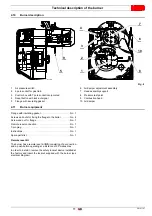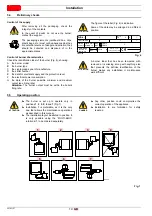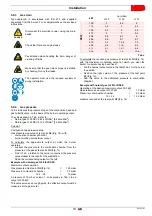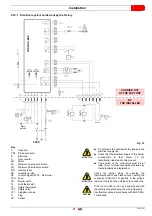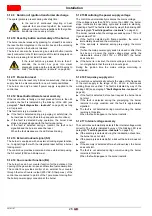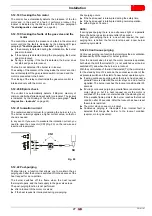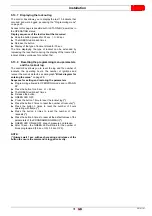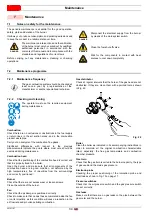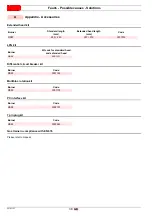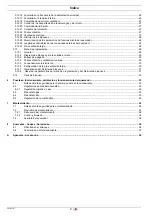
25
20141167
GB
Installation
5.12.3 Checking the gas pressure switch
When the gas pressure switch is open the motor is not powered.
If, after a heat request, the gas pressure switch open, the motor
stops and:
if the gas pressure switch stays open for more than 2 minutes,
the fault is displayed by the diagnostic LEDs.
if the gas pressure switch stays open for less than 2 minutes,
the fault is not displayed.
when the gas pressure switch closes again, the motor is
restarted if also the air pressure switch is open.
when the gas pressure switch is closed the motor is powered
for about a second (to acknowledge the signal) and then it is
shut off for 2 seconds to be then restarted and start the
operation cycle, if the gas pressure switch stays open for
more than 2 minutes.
If the gas pressure switch opens during normal flame operation,
the motor stops immediately and the gas valves are closed. If the
gas pressure switch opens during post-purging or during
continuous purging (if set), the motor stops and stays off for the
whole time that the gas pressure switch is open and the fault is
displayed immediately by the diagnostic LEDs.
5.12.4 Checking the air pressure switch
When the burner receives the heat request the air pressure
switch is checked and if it is closed (bonded) the motor does not
start and after 2 minutes the lockout condition is reached.
If after the motor starts on a heat request the air pressure switch
does not close within 15 seconds of pre-purging, the burner
reaches the lockout condition.
If there is a loss of air pressure after the first 15 seconds of pre-
purging but before the last 10 seconds, a recycle occurs (the pre-
purging time starts from when the air pressure switch closes in a
stable manner).
If after a recycle after a loss of air pressure there is a new loss,
the burner reaches an immediate lockout condition due to lack of
air.
If the loss of the air pressure switch occurs in the last 10 seconds
of the pre-purging time (before the start of the safety time) the
burner reaches an immediate lockout condition due to lack of air.
If there is a loss of the air pressure switch after the opening of the
1st stage valves or during normal operation with flame, the burner
reaches the lockout condition within 1s.
The state of the air pressure switch does not influence the post-
purging time.
If continuous purging is set, the motor is powered even if the air
pressure switch is sealed but only in a condition without a heat
request or after 2 minutes if the lockout occurred after the heat
request.
5.12.5 Switching off test
If the reset button or the remote reset is pressed during
operations for more than 5 seconds and less of 10 seconds, (to
not go to the successive menu) the burner switches off, the gas
valve closes, the flame goes out and the start-up sequence
restarts.
If the switch off test is enabled, the number of repetitions of the
start up sequence (see paragraph
“Recycle and limit of
repetitions”
on page 25) and the number of possible resets (see
paragraph
“External lockout signal (S3)”
on page 26), are
reset.
5.12.6 Intermittent operation
After 24 hours of continuous operation, the control box starts the
automatic switch-off sequence, followed by a restart, in order to
check for a possible fault with the flame detector. This automatic
switch-off can be fixed at 1 hour, (see paragraph
“Programming
menu”
on page 29).
The modification of the parameter setting for intermittent
operation takes effect if:
during the heat request, the switching off test function is
enabled;
there is a flame loss;
the heat request switches off and then later restarts;
the control box switches off and restarts;
the automatic restarting of the intermittent function occurs
(1hour/24hours).
5.12.7 Recycle and limit of repetitions
The control box allows a recycle, i.e. complete repetition of the
start-up sequence, making up to 3 attempts, in the event the
flame failure during operation.
If the flame failure 4 times during operations, this will cause the
burner to lock out. If there is a new heat request during the
recycle, the 3 attempts are reset when the limit thermostat (TL)
switches.
Disconnecting the power supply, when there is a new heat
request (power supply applied to the burner), all possible
attempts at a restart are reset (maximum 3).
5.12.8 Presence of an extraneous light or parasite
flame
The presence of a parasite flame or extraneous light can be
detected in the stand-by state after a heat request.
If the presence of a flame or extraneous light is detected also in
the "t2" stage, the motor does not start until the flame signal has
disappeared or until lockout has been reached.
If after the fan motor starts, during the pre-purging, an extraneous
light or parasite flame is detected, the burner reaches the lockout
condition in 1 second.
If, during the recycle due to flame disappearance while operating
and the consequent repetition of the start-up sequence, the
parasite flame or the extraneous light is detected before the
motor starts, the 25 seconds control countdown starts (for
checking for the presence of the parasite flame or the extraneous
light) otherwise the lockout occurs within 1 second.
The fault is indicated by the blinking LED (see paragraph
“Fault
diagnostics - lockouts”
on page 24).
When the heat request is finished, if the parasite flame stays on
the burner reaches the lockout condition due to parasite flame
after 25 seconds (regardless of the presence or otherwise of the
post-purging or the continuous purging).
The parasite flame control is active even when there is a fault with
the mains voltage, the frequency, the internal voltage, the
condition with gas pressure switch open.
The parasite flame control is not active only in lockout conditions.

